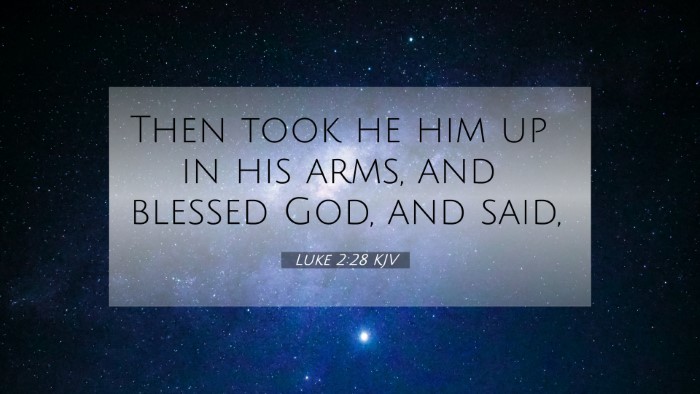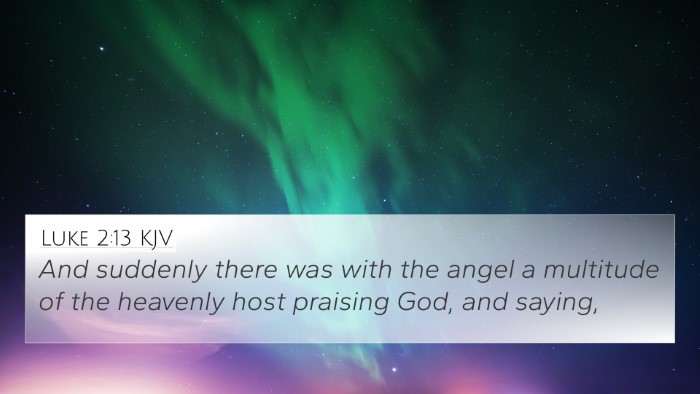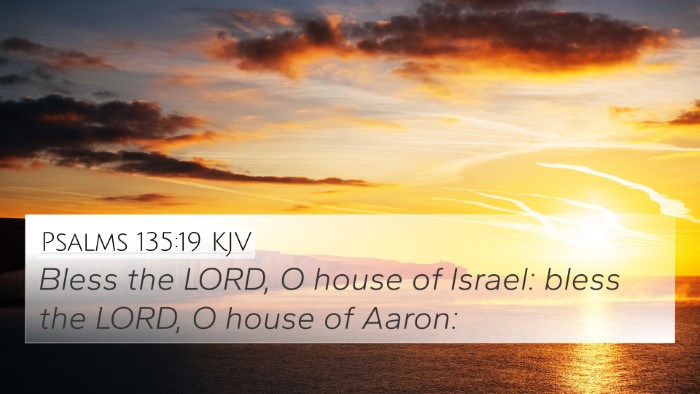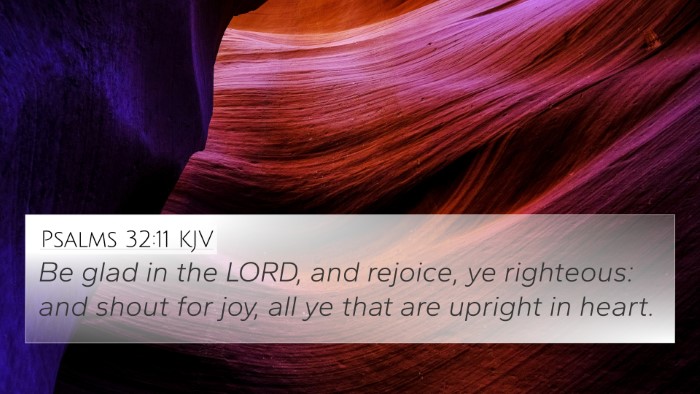Understanding Luke 2:28
Luke 2:28 says, "Then took he him up in his arms, and blessed God, and said," reflecting a moment of profound significance in the life of Simeon as he encounters the infant Jesus in the temple.
General Overview
This verse captures the culmination of Simeon's long wait for the Messiah. He had been promised that he would not die before seeing the Lord's Christ, and upon seeing Jesus, he rejoices, taking the child into his arms. There is both a physical and spiritual significance to this act, showcasing the fulfillment of God's promises to His people.
Commentary Insights
Matthew Henry’s Commentary
Henry notes that Simeon's action represents the joy of a faithful servant receiving the long-awaited gift of salvation. The act of taking Jesus in his arms symbolizes the embrace of all that Jesus represents—the hope of Israel and the revelation of God's mercy. This moment is central to the theme of God's fulfillment of promises.
Albert Barnes’ Notes
Barnes discusses the significance of Simeon's blessing. He emphasizes that Simeon acknowledges Jesus openly, praising God for the revelation of salvation. This public acknowledgment of Jesus is important for understanding who He is—a light to the Gentiles, and the glory of Israel. Barnes illustrates the connection between this event and the broader narrative of redemption that runs throughout Scripture.
Adam Clarke’s Commentary
According to Clarke, the phrase "blessed God" indicates Simeon's recognition of God's faithfulness. He had been waiting for the consolation of Israel and, upon seeing Jesus, is moved to worship. Clarke also points out the immediate connection to the Psalms, notably Psalm 130:5-6, where waiting for the Lord is a recurring theme, reflecting hope and redemption.
Thematic Connections
Luke 2:28 not only stands alone, but also connects to numerous themes found throughout the Bible:
- Faithfulness and Promise: Simeon’s experience is a direct representation of God's faithfulness to His promises, paralleling many Old Testament affirmations.
- Joy and Salvation: The joy that accompanies the revelation of Jesus is a theme mirrored in Psalms and the New Testament (Philippians 4:4).
- Recognition of Christ: The act of blessing God for Jesus reflects a significant moment echoed in Matthew 2:10-11 where the Magi also respond with joy upon finding Jesus.
Cross-References
This biblical verse has rich interconnections with several other scriptures:
- Isaiah 9:2: A prophecy of a great light coming to those in darkness, painting a picture of the hope that Simeon recognizes in Jesus.
- Luke 2:32: Following verse where Simeon describes Jesus as "a light for revelation to the Gentiles," connecting with the theme of Jesus’ universal impact.
- John 1:9: Where Jesus is referred to as the true light, further emphasizing Simeon’s declaration upon meeting Him.
- Luke 3:6: The prophetic declaration that all flesh shall see the salvation of God, which Simeon directly experiences.
- Acts 13:47: Paul references Isaiah to highlight that God’s salvation is for all, linking back to the promise fulfilled in Christ.
- Romans 1:16: Affirming that the gospel is the power of God unto salvation to everyone who believes, echoing Simeon’s recognition of Jesus as Savior.
- Hebrews 10:36: Speak to the fulfillment of promise, correlating to Simeon’s faithful wait in hope for the Messiah.
Finding Cross-References
When studying Luke 2:28, it's essential to utilize tools for identifying connections. Various resources, such as Bible concordances and cross-reference guides, can assist in uncovering related verses. Understanding the narrative of Simeon helps in recognizing the overarching themes across both the Old and New Testaments.
Conclusion
Luke 2:28 is a poignant verse that illustrates the fulfillment of God’s promises through the person of Jesus Christ. Simeon’s encounter serves as a beautiful reminder of the interconnectedness of scripture, where themes of faith, promise, and revelation converge. Engaging in cross-referencing Biblical texts not only enhances understanding but also enriches one's faith, making the reading of scripture a deeper and more meaningful journey.
Further Study Suggestions
For those interested in digging deeper, exploring how to find cross-references in the Bible opens up a variety of comprehensive Bible cross-reference materials. Identifying the connections between Old and New Testament passages can provide greater context and understanding of scripture, while comparative studies enhance one's overall grasp of Biblical themes and teachings.
Related Topics
- Bible cross-reference study methods: Techniques for exploring inter-Biblical dialogue.
- Examining links between the Prophets and Apostolic teachings: Understanding how Old Testament prophecies are fulfilled in the New Testament.
- Cross-referenced themes in the Bible: Unveiling the recurring motifs that define the Biblical narrative.












